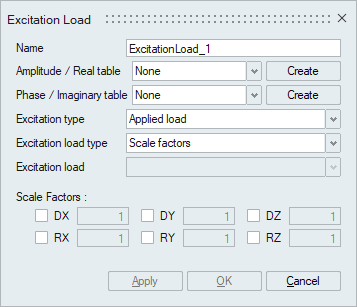Excitation Load
![]()
This tool is used to define excitation load for frequency response analysis.

Description
- Amplitude table is used to define dynamic load with amplitude as a function of frequency.
- Phase table is used to define dynamic load with phase as a function of frequency.
- The following dynamic load types can be selected
- Applied load
- Enforced displacement
- Enforced velocity
- Enforced acceleration
- Acoustic source (For Acoustic Analysis )
- The excitation load can be defined by one of the following way
- By selecting a node using Scale Factors option. In case of OptiStruct, this is equivalent to defining DAREA.
- By selecting a predefined force / pressure / body force / enforced constraint.
- For Random response analysis, the base motion can be applied on all the fixed constraints present in the solution.
Random Excitation Loading – Random Vibration

- In Random Vibration, the objective is to obtain the transfer function from frequency response and for the given PSD curve, we will obtain the PSD/RMS outputs.
- The Random vibration will be simulated assuming auto spectral density.
The power spectral density assuming auto spectral density of xth degree of
freedom (Same signals) is given by,
Sxo (f)= |Hxi (f)|2*Si (f). Where
Si (f) - Input PSD curve,
Hxi (f) - Receptance obtained from FRF results,
Sxo (f) - Output PSD curve.
- Auto or Cross spectral densities with/without preloading can be simulated by using load case approach.
- During solver input file export, Excitation load information will be
used to export the modal frequency response subcase and the PSD input curve
is used to export the random vibration subcase.
- If there are multiple excitation loads, each excitation load will be assumed as MFRF subcase, and by default the results of all the subcases can be obtained as superimposed output or as individual random vibration (individual receptance/MFRF) output by using the option “Combine random loading” under “Format and execute options”.
- There are two options available to specify the amplitude and phase table for extracting
the receptance (MFRF).
- Instantaneous loading: For given loading frequency range, the magnitude and phase remains constant. Note: For Abaqus, the instantaneous loading is always assumed as constant unit magnitude value with no phase, for given frequency range in solver settings.
- Tabular definition: User defined frequency vs magnitude curve.
- The following types of random excitation can be simulated for OptiStruct
and Abaqus (under no loadcase mode)
- Based on load (Applied load):
- Pressure: Unit of PSD curve is Pa2/Hz.
- Force: Unit of PSD curve is N2/Hz.
- Moment: Unit of PSD curve is N2m2/Hz.
- Body force
- Acceleration: Unit of PSD curve is m2/s4/Hz.
- Angular velocity: Unit of PSD curve is rad2/s2/Hz.
- Angular acceleration: Unit of PSD curve is rad2/s4/Hz.
- Scale factors. Unit of PSD curve is no unit.
- Base motion excitation: Random excitation applied on all fixed
constraints/ selected enforced constraints.
- Base displacement: Unit of PSD curve is m2/Hz.
- Base velocity: Unit of PSD curve is m2/s2/Hz.
- Base acceleration: If the base acceleration is applied on fixed constraints, the input PSD curve will be assumed as g2/Hz and the unit loading value will be assumed as 9.806 m/s2.
- Based on load (Applied load):
- White noise based random vibration.
- Random vibration on connectors.
Cards supported for various solvers
| Solver | Supported Cards |
|---|---|
| OptiStruct |
DLOAD, DAREA (if Excitation load type = scale factors) RLOAD2 (Amplitude table - Freq Vs Amplitude type; Phase table - Freq Vs phase type) RLOAD1 (Amplitude table - Freq Vs Excitation Real type; Phase table - Freq Vs Excitation Imaginary type) DLOAD, ACSRCE, SLOAD (If Excitation type = Acoustic source, Amplitude table - Freq Vs power type) |
| Abaqus |
*Base Motion, Dof = {DOF}, Amplitude = {Amplitude name}, {Real/Imaginary} (If Excitation load type = scale factors) *Base Motion, Dof = {DOF}, Type = {Accleration / Velocity / Displacement}, Base Name = {Base name}, Amplitude = {Amplitude name}, {Real/Imaginary} (If Excitation load type = Enforced constraints) *Cload, Amplitude = {Amplitude name}, {Real/Imaginary} (If Excitation load type = Force) *Dsload, Amplitude = {Amplitude name}, {Real/Imaginary} (If Excitation load type = Pressure) *Dload, Amplitude = {Amplitude name}, {Real/Imaginary} (If Excitation load type = Body force) *Amplitude (Amplitude table - Freq Vs Excitation Real type; Phase table - Freq Vs Excitation Imaginary type) |
| ADVC | $ExcitationLoad, $FrequencyDependentTable |